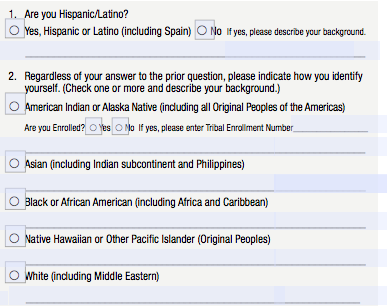Erika Roach ’13 identifies herself as “Blasian,” while Marcus Montanez-Leaks ’13 says he’s “Blexican.”
These terms and others used to describe mixed race individuals are becoming more common in conversation and student groups focused on mixed race issues have begun popping up on campus, a trend mirroring the rise in applications.
Mixed race applicants to Stanford are “one of the fastest growing groups,” according to Dean of Admissions Richard Shaw.
During the 2011-12 academic year, 11.6 percent of undergraduates identified their racial/ethnic category as “two or more races,” up from 8.4 percent the previous year. 2010-11 was the first year the University began collecting data on mixed race individuals.
In 2011, the Department of Education started requiring universities to collect more information about applicants’ race and ethnicity. Many college applications, including the Common Application that Stanford uses, now allow students to check multiple boxes when it comes to describing their racial and ethnic identities.
“Students [telling] us exactly what their racial background is … not a mandatory request. It is optional,” Shaw said. He added that the ability to self-identify accurately is a crucial part of the college admissions process.
For students who identify with more than one heritage, the ability to check all that apply on the racial background section of college admissions proves crucial to establishing their identity.
“When we were younger, a lot of times we were torn,” Roach, who is Puerto Rican on her father’s side and Filipino on her mother’s side, said. “Which box do you check when you identify with both sides? People were telling you that you’d have to choose between your heritage.”
The new boxes and check marks on the Common Application didn’t come without criticism. A 2011 New York Times article raised concerns that these increased options may enable students to cheat admissions and favor the race they believe will boost their admission chances, assuming the college uses affirmative action in admissions decisions.
Michele Elam, English professor and author of a 2011 book on mixed race, The Souls of Mixed Folk: Race, Politics and Aesthetics in the New Millennium, argues that diversity remains an important consideration among many others in college admissions, but does not believe that students are simply “cynically trying to game the system by checking as many boxes as possible.”
“A lot of young high school students when doing college admissions are just coming of age politically and racially,” Elam said. “Some may not have thought of themselves as having a distinct mixed identity before being asked to check multiple boxes.”
For Montanez-Leaks, whose mother is Mexican and father is African American, race is a matter of pride.
“It’s my identity,” he said. “It’s part of who I am.”
Elam also said the more specific application boxes help to promote diversity on campus. Without the option to identify race, or races as the case may be, on college applications, colleges could not document statistics or ensure a truly diverse student body with regard to race and ethnicity.
Montanez-Leaks and Roach serve as presidents of The Multiracial Identified Community at Stanford (MICS), which Montanez-Leaks said “provides a space where you can completely be yourself.” Likewise, Roach feels at liberty to explore her identity through multiple lenses.
“I think race is very much who I am, “Roach said. “I identify with black issues. I identify with Filipino issues. I identify with Asian issues. I don’t ever let other people try to define me by my race. I am proud to represent both of my races and I feel they are very much a part of me.”
For Roach, the community and the option to mark both races with which she identifies allow her to present herself in accordance with her self-image.
“I marked both boxes because that’s who I am,” Roach said. “I always knew how I identified, it was very convenient on the application to have those options.”
While college applications and University statistics are quickly catching up, Elam says the process is far from over. Progress is admirable, but mixed race is still a “category in the making.”
